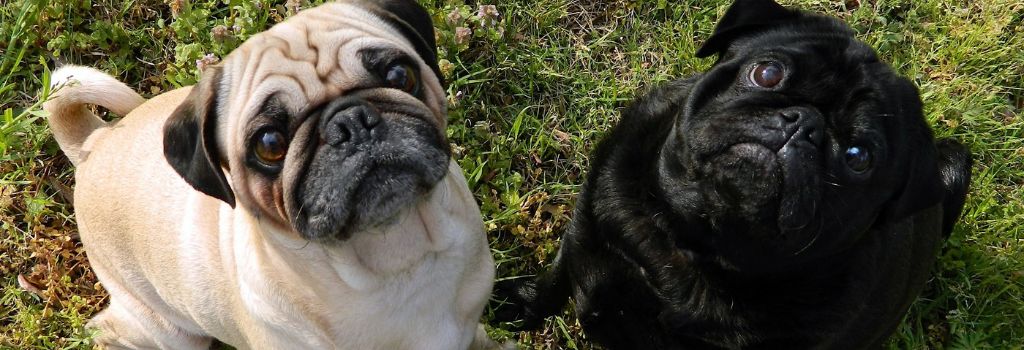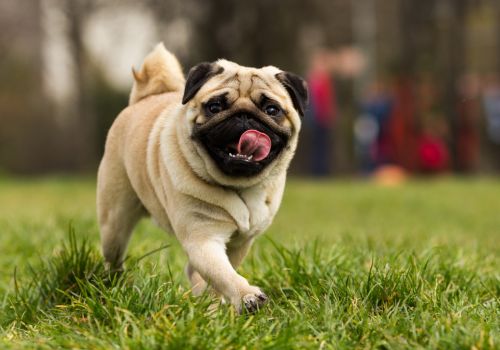If you've got one of these delightful fur-babies at home, then you know you've struck gold in the canine companionship lottery. Let's talk about why Pugs are not just pets, but pint-sized bundles of joy that bring a smile to anyone fortunate enough to meet them.
The Pawsitive Traits of a Pug
If you chose a Pug, you were probably looking for a dog that's easy-going and playful without requiring an Olympic-level workout routine. These little critters are energetic in bursts but are also content with moderate exercise. Their small yet sturdy frame makes them excellent companions for both kids and adults alike.
While they might not win any "Best Guard Dog" competitions, they are still vigilant watchdogs, always ready to alert you with a hearty bark. Best of all, Pugs are known for their even-tempered, affectionate nature. They’re happy-go-lucky creatures that get along with kids and other pets, making them wonderful family dogs.

The Not-So-Perfect Side
Well, no pet is perfect, and Pugs have their quirks, too. For starters, they can be a bit stubborn and independent. On the health side, they are prone to a range of issues, so be prepared for some vet visits. And let's talk about the noises: snorts, snuffles, and wheezes are the Pug's trademark sounds, and yes, they snore.
Housetraining them can be a challenge. They also are better suited as indoor dogs because they don't tolerate heat well. And if you're thinking of leaving your Pug alone for long periods, think again. These social butterflies can get bored and anxious, leading them to find rather inventive ways to get into trouble.
But Is It Worth It?
Absolutely! I mean, who can resist those big, soulful eyes? Pugs are jolly little souls that make excellent travel buddies and are genuinely full of personality.
A Bit of Puggy History
Pugs have a rich and rather royal background. Originating in China, they were often the pampered pets of emperors, complete with personal guards and lavish palaces. These dogs were so prized that they even had their own chefs! And it seems that modern Pugs haven't forgotten their royal roots—many Pug owners would say their pets still act like little kings and queens.
First recognized by the American Kennel Club in 1885, Pugs quickly became a beloved addition to American households. Given their moderate exercise needs, they are perfect pets for apartment dwellers or those with smaller living spaces.
Pugs are generally healthy, with an average lifespan ranging between 13 to 15 years. With proper care and lots of love, your Pug will be a loyal and loving companion for years to come. Trust us, a life with a Pug is a life full of love and laughter!

Genetic Predispositions for Pugs
Liver Problems in Your Pug
Did you know that our wrinkly-faced furballs are more prone to a liver disorder called Portosystemic Shunt (PSS)? Essentially, it means that some of the blood that should flow through the liver skips the pitstop, depriving the liver of essential nutrients and the chance to filter toxins. If you're ever scheduling anesthesia for your Pug, make sure they get a liver function test along with the standard pre-anesthetic panel. If you notice symptoms like stunted growth or, heaven forbid, seizures, it's time for some serious chats and checks with your vet. Sometimes, this can be managed with medication and a special diet, but in more severe cases, surgery might be the way to go.
Chylothorax in Pugs: Rare but Serious
Our beloved Pugs can also face something called chylothorax, where a milky substance known as chyle accumulates in the chest cavity. Though it's uncommon, it's seriously bad news and requires immediate medical attention. Are you wondering what to look out for? Keep an eye on any signs of difficulty breathing, coughing, or unusual lethargy. In many cases, surgery becomes necessary to manage the disease.
The Importance of Eye Care for Pugs
Our Pugs' eyes can say a thousand words, but they're also vulnerable to several conditions that can seriously affect their quality of life. Because Pugs have those adorable protruding eyeballs, they're susceptible to corneal scrapes and punctures. Make sure your little guy isn't hanging his head out of the car window; it's a common way for them to injure their eyes. And if you see any issues? Call the vet ASAP. Conditions like entropion, where the eyelid rolls inward, and dry eye are painful but treatable if caught early.
The “Sweet” Truth About Pugs and Diabetes
Diabetes is no longer just a human problem; it's making its way into the canine world too. Pugs are at above-average risk for diabetes mellitus, a condition that messes with the metabolism of sugars and requires daily insulin injections. If your Pug is eating and drinking more than usual but losing weight, it's time to consult the vet. The good news? Well-regulated diabetic dogs can have the same life expectancy as their non-diabetic pals.

Allergies and Your Pug
Your Pug won't start sneezing or get watery eyes like humans do. Instead, allergies make their skin super itchy. This condition, known as atopy, can make your Pug want to lick their paws, rub their face, or lead to frequent ear infections. If your Pug is showing these signs, especially between the ages of one and three, consult your vet. There are lots of treatments available to keep your fur baby comfortable.
Your Pug's Mysterious Mites: All About Mange
It may sound creepy, but did you know that all dogs have tiny microscopic mites called Demodex living in their hair follicles? Normally, these little critters are harmless. However, our cute Pugs can sometimes have a mite party that gets out of control. When this happens, you might notice dry patches, hair loss, or irritated skin, often around the face or paws. This is a condition known as mange. Catching it early is key, so keep an eye out and head to the vet for some much-needed relief for your furry friend. Some dogs outgrow this condition, but others may need lifelong management.
Those Pesky Skin Folds: Battling Lip-Fold Pyoderma
Ah, the signature Pug wrinkles! While they make your Pug irresistibly adorable, they can also be a hiding spot for bacteria and yeast, leading to lip-fold pyoderma. This results in smelly, red, and uncomfortable areas around their lower jaw. So if you notice these signs, let your vet know right away. Antibiotics or even minor surgery can often clear up this condition and make your Pug feel and smell fresh again!
Navigating the Unknown: Granulomatous Meningoencephalitis (GME)
While it’s a mouthful to say, GME is a serious and often devastating condition that affects a dog's central nervous system. It can cause irreversible damage to the brain and is unfortunately more common in middle-aged, small breed dogs like Pugs. Symptoms can be acute and severe, sometimes even affecting just the eyes. Treatment is complex and prognosis is generally poor, so early detection and immediate veterinary care are critical.
All About That Bass: Bone and Joint Issues in Pugs
Your energetic Pug could be more susceptible to several musculoskeletal conditions, from dysplasia in the hips and elbows to Legg-Calve-Perthes Disease affecting the hip joints. Keep an eye out for any stiffness, limping, or difficulty moving, and remember that an early diagnosis is always better. And hey, maintaining a healthy weight can help keep arthritis at bay!
When Spines Don’t Align: Spinal Deformities in Pugs
Spinal deformities like hemivertebrae may be more common in Pugs than in other dog breeds. These can cause spinal cord damage and potentially lead to disabilities, especially as your Pug ages. Keep your vet in the loop, especially if you notice any back-related issues. Diagnostic Imaging and other treatments may be recommended.

The Sneaky Lumps: Mast Cell Tumors
Those little lumps and bumps on your Pug's skin could be more than just harmless blemishes. Pugs are more susceptible to mast cell tumors, a type of skin cancer. Early detection is crucial, so any new or suspicious lumps should be checked out ASAP. The good news? Many of these tumors can be cured if caught and removed early.
Hind Leg Woes: Understanding Degenerative Myelopathy
Degenerative Myelopathy is a heartbreaking condition similar to ALS in humans, affecting the hind legs and leading to paralysis. Unfortunately, it’s more common in Pugs. There's no cure, but some treatments like exercise, acupuncture, and dietary supplements might offer some relief. Genetic tests can help you assess the risk for your Pug.
Stony Struggles: Bladder or Kidney Stones in Pugs
Your Pug's tiny body can sometimes form kidney or bladder stones, which are as painful for them as they sound. Symptoms like bloody urine or straining to urinate are red flags. Immediate veterinary attention is needed, so don't hesitate to call your vet.
The Breathless Pug: Respiratory Distress Syndrome
Last but not least, those cute snub noses can sometimes cause breathing difficulties, known as Respiratory Distress Syndrome. This is due to the Pug's unique anatomy, which makes it hard for them to get enough air. Look out for signs like heavy panting, blue gums, or fainting. Surgical correction may be an option in severe cases.
If you have questions and you'd like to reach out to us, you can call us directly at (817) 435 4783, or you can email us at [email protected]. Don't forget to follow us on social media Facebook, Instagram.
